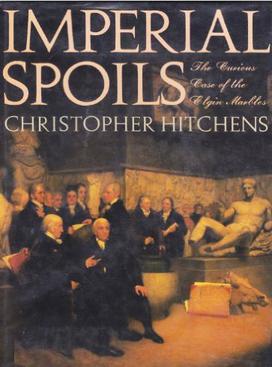Imperial Spoils facts for kids
 |
|
| Author | Christopher Hitchens |
|---|---|
| Country | United States |
| Language | English |
| Subject | Elgin Marbles |
| Publisher | Chatto and Windus (UK)/ Hill and Wang (US) |
|
Publication date
|
1987 (UK) / 1988 (US) |
| Media type | Print (Hardback & Paperback) |
| Pages | 137 |
| ISBN | 978-0-8090-4189-3 |
Imperial Spoils: The Curious Case of the Elgin Marbles is a book from 1987 by Christopher Hitchens. It talks about a big argument over some ancient Greek sculptures. These sculptures, known as the Elgin Marbles, were taken from the Parthenon temple in Greece by Thomas Bruce, 7th Earl of Elgin. Later, he sold them to the British Museum. Hitchens' book looks at the history of these amazing artworks and asks if they should go back to Greece.
Contents
Understanding the Elgin Marbles Debate
This book explores a long-standing debate. It's about whether ancient Greek sculptures should stay in the British Museum or return to Greece. The sculptures are very famous. They are called the Elgin Marbles.
What Are the Elgin Marbles?
The Elgin Marbles are a collection of ancient Greek sculptures. They were once part of the Parthenon. This temple is on the Acropolis in Athens, Greece. The sculptures include parts of a long carving called a frieze. This frieze showed a procession of people and gods. There are also statues and other pieces. They are made of beautiful marble.
The Parthenon was built over 2,400 years ago. It was a temple for the goddess Athena. These sculptures are very important. They show the amazing art skills of ancient Greece. They tell stories about Greek myths and history.
Who Was Lord Elgin?
Thomas Bruce, 7th Earl of Elgin was a British diplomat. He was the ambassador to the Ottoman Empire in the early 1800s. At that time, Greece was part of the Ottoman Empire. Lord Elgin got permission to remove some sculptures. He said he wanted to protect them. He took many pieces from the Parthenon. These included about half of the frieze. He also took several statues.
Lord Elgin shipped these sculptures to Britain. He later sold them to the British government. In 1816, they became part of the British Museum's collection. They have been there ever since.
Why Is There a Debate About Their Return?
The debate over the Elgin Marbles is very old. It asks if they should be returned to Greece.
Arguments for Returning the Marbles
Many people believe the Marbles should go back to Greece. They say the sculptures are a key part of Greek heritage. They were made for the Parthenon. They belong in their original home. Greece has built a new museum. It is called the Acropolis Museum. This museum is right next to the Parthenon. It was designed to house the Marbles. Supporters say it's important for cultural unity. They believe it would correct a historical wrong.
Arguments Against Returning the Marbles
Others argue the Marbles should stay in the British Museum. They say Lord Elgin had permission to take them. They also argue that the British Museum is a universal museum. It displays art from all over the world. This allows many people to see them. They also say the Marbles have been well cared for. They have been protected from pollution and damage. Some worry that returning them could set a precedent. This might lead to other museums losing their collections.
Christopher Hitchens' Book
Christopher Hitchens' book, Imperial Spoils, looks closely at this debate. He argues strongly that the Elgin Marbles should be returned to Greece. He examines the history of how they were taken. He questions the reasons given for their removal. Hitchens' book adds to the discussion. It highlights the cultural and historical importance of these sculptures. It also explores the idea of cultural ownership.

